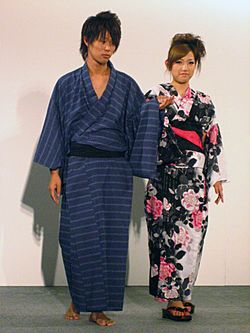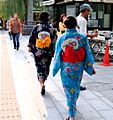Yukata facts for kids

Men's and women's yukata
|
|
| Type | Casual summer kimono |
|---|---|
| Place of origin | Japan |
A yukata (浴衣, lit. bathrobe) is a special type of kimono worn in Japan. It's usually made of cotton and doesn't have a lining, making it perfect for summer. People wear yukata for fun, especially at summer festivals and when visiting hot spring resorts.
Long ago, yukata were mostly used as bathrobes. But today, they are worn for many more things and are a common sight in Japan during the warm months. While traditional yukata were often blue and white, modern ones come in many bright colours and patterns. They are also designed to be easy to wash in a machine. Yukata look a bit like a nemaki, which is a simple, short-sleeved kimono-like outfit worn by guests at traditional Japanese inns.
Contents
What is a Yukata?
A yukata is a casual summer kimono. It's a traditional Japanese garment that is lighter and simpler than a formal kimono. People wear yukata to stay cool and comfortable during the hot Japanese summer.
How to Wear a Yukata
Yukata are worn by both boys and girls, and men and women. Just like other traditional Japanese clothing, yukata have straight seams and wide sleeves.
- Men's yukata have shorter sleeves, about 10 centimeters long from the armpit.
- Women's yukata have longer sleeves, about 20 centimeters long from the armpit.
A typical yukata outfit includes:
- The yukata itself.
- An obi, which is a special belt or sash that holds the yukata closed.
- Sandals or geta (wooden clogs) worn without socks.
People often add accessories like a foldable hand fan to keep cool. They might also carry a traditional bag called a kinchaku. This small bag is used by everyone to carry things like cellphones or other personal items.
When you wear any kimono, including a yukata, you always wrap the left side over the right side. This is important! The yukata is then held in place with an obi. The obi can be stiff or soft, but it's usually just one layer.
Colours and Designs
For a long time, most yukata were made from cotton dyed with indigo, which gives them a deep blue colour. However, in the late 1990s, yukata became much more popular. Now, you can find them in a huge variety of colours and designs, worn by both men and women.
Where Yukata Are Worn Today
Even though yukata were once worn as bathrobes all year round, this is not common anymore. Today, you mostly see them used as bathrobes in special onsen (hot spring) towns. Places like Atami, Kinosaki, and Kusatsu are famous for this. In these towns, hotels and inns often give yukata to their guests to wear during their stay.
See also
 In Spanish: Yukata para niños
In Spanish: Yukata para niños




